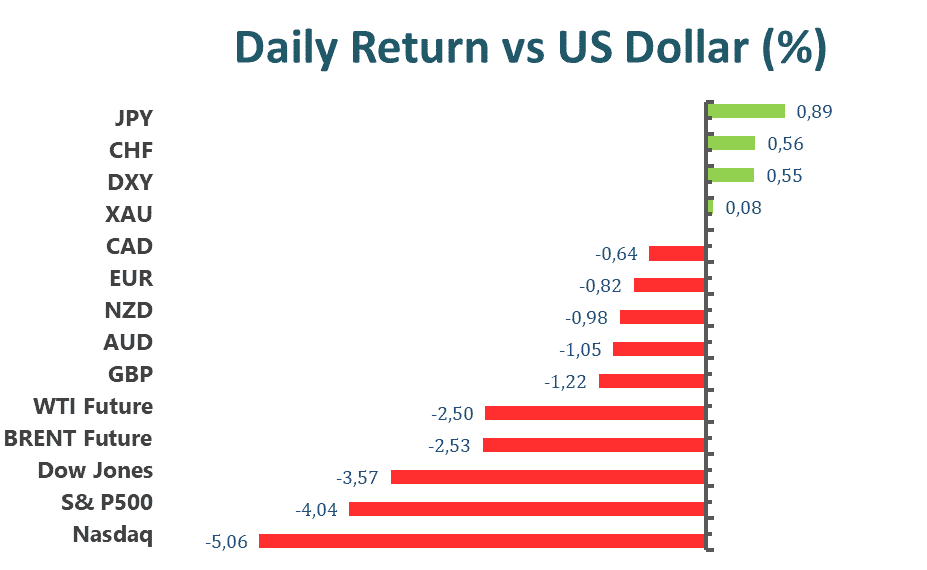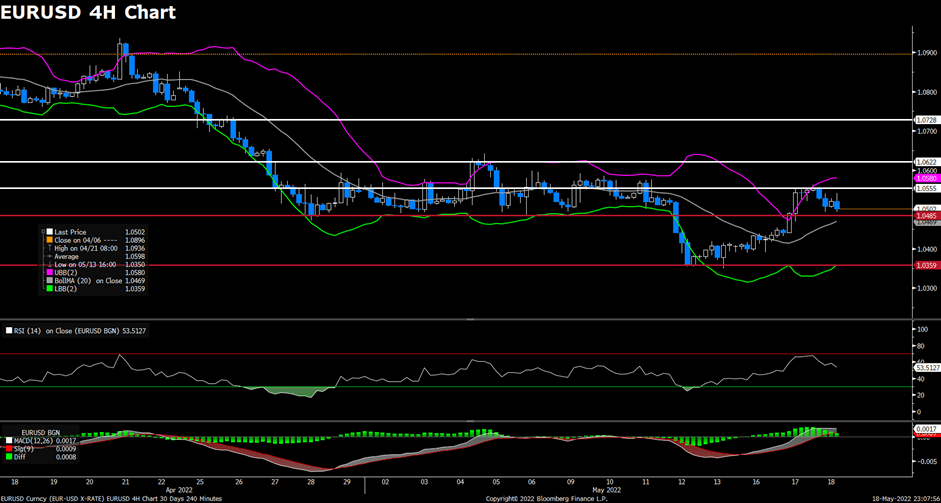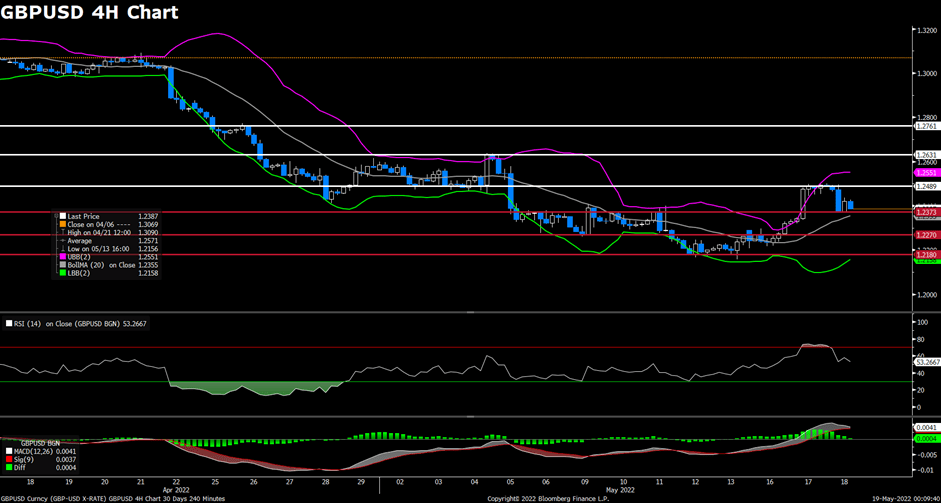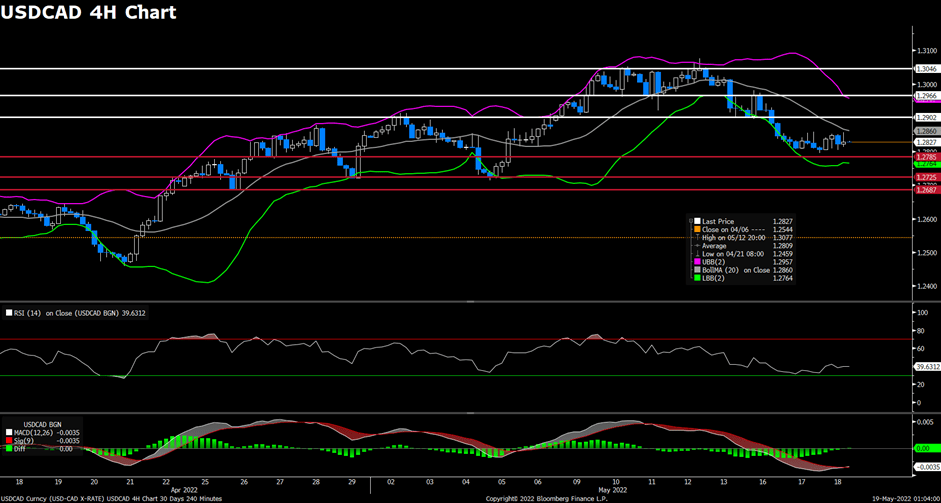U.S. equities markets fell sharply over the previous trading day. The Dow Jones Industrial Average lost 3.57% to close at 31490.07. The S&P500 dropped 4.04% to close at 3923.68. The Nasdaq composite plummeted 4.73% to close at 11418.16. The Dow Jones’ 3.57% drop marked its biggest loss since 2020 as market participants sold off equities over fears of inflation and slowed growth as the earnings season continue.
Four major U.S. retailers announced Q1 earnings reports this week. While Home Depot was able to beat earnings estimates and raise forward guidance, the others fail to deliver such a positive tone. Walmart and Target both reported a hit to their profits as supply chain issues eat into Q1 profits; furthermore, comments from these two companies paint a sluggish economic outlook. Macy’s, Nordstrom, and Gap are set to release Q1 earnings later in the month. Market participants should pay close attention to these reports as they could reveal key consumer spending information.

On the economic docket, the U.S. is due to release initial jobless claims as well as the Philadelphia Fed Manufacturing Index for May during today’s American trading session. On the 20th the U.K. will release its monthly retail sales figures for April.

Main Pairs Movement
The U.S. Greenback showed broad-based strength over the previous trading day. The Dollar Index snapped its three-day losing streak and gained 0.58% by market close. With Walmart and Target missing earnings estimates, market participants continue to be uncertain about the inflation peak and continue to anticipate further rate hikes by the Fed. Today’s scheduled U.S. initial jobless claims report will paint a better picture of U.S. labor markets.
EURUSD lost 0.8% over the previous trading day. The large-scale sell-off of U.S. equities sparked a flight to safety among market participants, thus buoying the U.S. Dollar. The Fed’s hawkish stance continues to favor the Greenback over the Euro.
The cable dropped 1.22% over the previous trading day. Britain’s CPI figure came in at a 40-year high of 9%, and food and energy prices contributed most to the jump in prices. Previous bearish economic remarks by the BoE and soaring U.K. inflation disfavored the Sterling.
USDCAD climbed 0.6% over the previous trading day. Strengthened Dollar and risk-averse sentiment helped the Dollar snap its three-day losing streak against the Canadian Loonie.
Technical Analysis
EURUSD (4-Hour Chart)

The EUR/USD pair declined on Wednesday, pulling back from weekly highs as the risk-averse market environment underpinned the dollar and helped it stay resilient against its rivals. The pair remained under bearish pressure during the first half of the day, then refreshed its daily low below the 1.0500 mark in the early US session. The pair is now trading at 1.0496, posting 0.47% losses daily. EUR/USD stays in the negative territory amid renewed US dollar strength, as Fed Chair Jerome Powell’s hawkish comments on Tuesday lend support to the greenback. He said that he will back interest rate increases until prices start falling back toward a healthy level. For the Euro, firmer speculation that the ECB could raise rates at some point in the summer should limit the losses for EUR/USD pair. On the economic data side, Eurozone’s Inflation rose 7.4% in April and disappointed the market’s expectations of 7.5%.
For the technical aspect, the RSI indicator is 55 figures as of writing, suggesting that the pair is facing some downside momentum as the RSI started to move south. As for the Bollinger Bands, the price fell from the upper band and dropped towards the moving average, therefore downside movements can be expected for the pair. In conclusion, we think the market will be bearish as the pair is heading to test the 1.04858 support. Further losses could be expected if the pair extends its slide below that support.
Resistance: 1.0555, 1.0622, 1.0728
Support: 1.0485, 1.0359
GBPUSD (4-Hour Chart)

The pair GBP/USD tumbled on Tuesday, struggling to capitalize on its recent strong rebound and attracted aggressive selling after the UK CPI report. The pair lost its upside tractions and dropped to a daily low below the 1.2380 level in the early European session, then rebounded slightly to recover some of its daily losses. At the time of writing, the cable stays in positive territory with a 0.84% loss for the day. The rising US Treasury bond yields and risk-off market mood continued to help the US dollar to fine demand, as Fed Chair Jerome Powell’s hawkish comments reaffirmed the expectations for a more aggressive policy tightening by the US central bank. For the British pound, the UK Consumer Prices Index (CPI) rose to 9% in April, which missed the market’s estimates of 9.1%. The downbeat CPI data have fueled the fears of stagflation and exerted bearish pressures on the GBP/USD pair.
For the technical aspect, the RSI indicator is 53 figures as of writing, suggesting that the risk remains skewed to the downside as the RSI keeps heading south. For the Bollinger Bands, the price resumed its decline and dropped towards the moving average, indicating that the downside traction should persist. In conclusion, we think the market will be bearish as the pair is heading to test the 1.2373 support. Technical indicators have lost their bullish strength and further losses could be expected on a break below that support.
Resistance: 1.2489, 1.2631, 1.2761
Support: 1.2373, 1.2270, 1.2180
USDCAD (4-Hour Chart)

As the downbeat market sentiment underpinned the US dollar and the hotter-than-expected Canadian CPI report failed to push the loonie higher on Wednesday, the pair USD/CAD edged higher and rebounded back towards the 1.285 area. The pair attracted some buying during the Asian session, then preserved its upside momentum and refreshed its daily top in the early US session. USD/CAD is trading at 1.2837 at the time of writing, rising 0.22% daily. The fears about aggressive Fed tightening this year amid Fed Chair Jerome Powell’s hawkish remarks on Tuesday continued to act as a tailwind for the safe-haven greenback. On top of that, the retreating crude oil prices also weighed heavily on the commodity-linked loonie as WTI has dipped back towards the $110 per barrel area. The downturn in macro risk sentiment has undermined the black gold despite further updates showing an easing of lockdown restrictions in Shanghai.
For the technical aspect, the RSI indicator is 39 figures as of writing, suggesting that the downside is more favored as the RSI stays below the mid-line. For the Bollinger Bands, the price failed to cross above the moving average, therefore the downside traction should persist. In conclusion, we think the market will be slightly bearish as the pair is heading to test the 1.2785 support. Sustained weakness below the aforementioned support would make the pair vulnerable to slide towards the next support, around the 1.2725 regions.
Resistance: 1.2902, 1.2966, 1.3046
Support: 1.2785, 1.2725, 1.2687
Economic Data
| Currency | Data | Time (GMT + 8) | Forecast |
| AUD | Employment Change (Apr) | 09:30 | 30.0K |
| NZD | Annual Budget Release | 10:00 | |
| EUR | ECB Publishes Account of Monetary Policy Meeting | 19:30 | |
| USD | Initial Jobless Claims | 20:30 | 200K |
| USD | Philadelphia Fed Manufacturing Index (May) | 20:30 | 16.0 |
| USD | Existing Home Sales (Apr) | 22:00 | 5.65M |